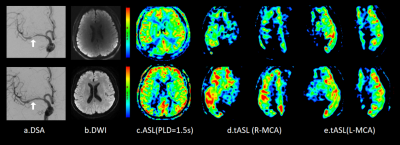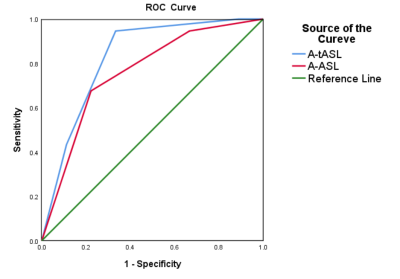Xinyu Wang1, Weiqiang Dou2, Xinyi Wang1, Kunjian Chen1, Huimin Mao1, and Yu Guo1
1Radiology department, The First Affiliated Hospital of Shandong First Medical University, Jinan, China, 2MR Research China, GE Healthcare, Beijing, China
1Radiology department, The First Affiliated Hospital of Shandong First Medical University, Jinan, China, 2MR Research China, GE Healthcare, Beijing, China
3D pseudo-continuous territorial arterial spin labeling can effectively diagnose patients with recanalization of unilateral middle cerebral artery stenosis.

Figure 1. A patient with R-MCA undergoing stenting before (top row) and after (bottom row) surgery. A 65-year-old male with a severe R-MCA stenosis. a. DSA:after stenting, the stenosis of the R-MCA was significantly alleviated, the blood flow was recanalization.b. Preoperative ASL :low perfusion area was visible in M6, postoperative low perfusion basically returned to normal level. c.d. Preoperative tASL : the perfusion in M3, M5 and M6 areas was lower than the contralateral side, and the postoperative hypoperfusion area basically returned to normal level.

Fig 2 The ROC curve shows the sensitivity and specificity values for predicting good clinical outcomes with the ASPECTS score of ASL and tASL at various levels of cut-off scores. Predictive value of good prognosis based on the ASPECTS score in postoperative tASL technology(AUC=0.829;95%CI:0.651-1.000 P<0.05) higher than ASL (AUC=0.760;95%CI:0.574-0.946 P<0.05).